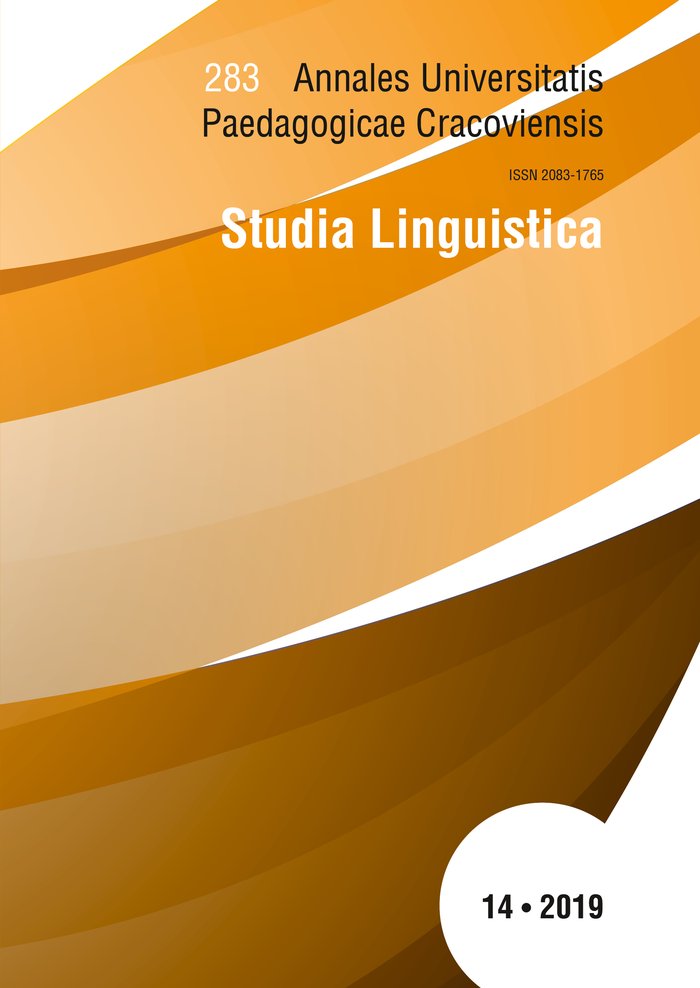Semantyczna historia obieżyświata
Main Article Content
Abstrakt
The article concerns the semantic development of the compositum obieżyświat ‘a person who likes to travel a lot’. It is interesting that the first attestation of the word in Old Polish (from the 15 th century) had a botanical meaning ‘Bupleurum rotundifolium L.’. The form obieżyświat was then the translation of the Old Latin plant names garowaga and girambula meaning ‘something that moves around’. The contemporary meaning of the compositum obieżyświat appeared only in the second half of the 19 th century.
Downloads
Article Details
Autor, zgłaszając tekst do redakcji czasopisma „Annales Universitatis Paedagogicae Cracoviensis. Studia Linguistica”, zaświadcza, iż jest on rezultatem wyłącznie jego własnej twórczości, że treść artykułu nie była dotychczas publikowana oraz że utwór nie narusza w żadnym stopniu praw autorskich ani praw pokrewnych innych osób, jak również innych praw osób trzecich, a także, że niczyje prawa do utworu (lub jego jakiejkolwiek części) nie zostały pominięte. Po podpisaniu umowy prawa majątkowe do opublikowanych materiałów zostają przeniesione na Wydawnictwo Naukowe Uniwersytetu Komisji Edukacji Narodowej w Krakowie.
Rocznik „Annales Universitatis Paedagogicae Cracoviensis. Studia Linguistica” to czasopismo o otwartym dostępie, a cała jego zawartość jest udostępniana bezpłatnie dla użytkowników i instytucji na zasadach licencji Creative Commons CC-BY-NC-ND 4.0 (uznanie autorstwa, użycie niekomercyjne, bez utworów zależnych). Na podstawie tej licencji autorzy zgadzają się, że ich prace mogą być zgodnie z prawem ponownie wykorzystywane do jakichkolwiek celów, za wyjątkiem celów komercyjnych, bez konieczności uzyskania uprzedniej zgody ze strony autora lub wydawcy. Każdy może prace te czytać, pobierać, kopiować, drukować, rozpowszechniać oraz przetwarzać, pod warunkiem poprawnego oznaczenia autorstwa oraz oryginalnego miejsca publikacji. Publikowanych tekstów nie można wykorzystywać do tworzenia utworów zależnych (np. do tłumaczenia ich i publikowania w innym języku bez zgody wydawcy). Jest to zgodne z definicją otwartego dostępu BOAI (Budapest Open Access Initiative) „Studia Linguistica”nie pobiera opłat za składanie artykułów ani ich przetwarzanie.
Autor, przesyłając artykuł do redakcji „Studia Linguistica”, bezwględnie zgadza się z poniższymi punktami:
-
Oświadczam, że jestem Autorem lub Współautorem nadesłanego tekstu. Przesłany tekst nie był nigdzie publikowany, jest całkowicie oryginalny i nie narusza w żadnym stopniu praw autorskich ani praw pokrewnych innych osób, jak również innych praw osób trzecich, a także, że niczyje prawa do utwory nie zostały pominięte.
-
Oświadczam, że nadesłany tekst nie został złożony do recenzji lub/i publikacji w innym czasopiśmie.
-
Przyjmuję do wiadomości, że Autor ponosi pełną odpowiedzialność za każdy przypadek plagiatu, niezależnie od tego, czy został on wykryty podczas procesu recenzji, czy po publikacji w „Studia Linguistica”.
-
Oświadczam, że ponoszę pełną odpowiedzialność finansową i prawną za wszelkie roszczenia związane z utworem.
-
Potwierdzam uznanie wszystkich źródeł danych wykorzystanych i cytowanych w badaniach.
-
Potwierdzam, że artykuł został wykonany z należytą starannością zgodnie ze standardami edytorskimi „Studia Linguistica”.
Bibliografia
Dębowiak P., Ostrowski B., Waniakowa J., 2017, „Etymology in the Polish Academy of Sciences Great Dictionary of Polish”, Lexikos, 27, s. 597−608.
Google Scholar
Genaust H., 2005, Etymologisches Wörterbuch der botanischen Pflanzennamen, Dritte, vollständig überarbeitete und erweiterte Ausgabe, Hamburg.
Google Scholar
Machek V., 1954, Česká a slovenská jména rostlin, Praha.
Google Scholar
Marzell H., 2000, Wörterbuch der deutschen Pflanzennamen, t. I−V, Lizenzausgabe Parkland Verlag, Fotomechanischer Nachdruck der Erstausgabe 1943−1958, Köln.
Google Scholar
Spólnik A., 1990, Nazwy polskich roślin do XVIII wieku, Prace Komisji Językoznawstwa PAN w Krakowie, nr 58, Wrocław.
Google Scholar
Waniakowa J., 2012, Polskie gwarowe nazwy dziko rosnących roślin zielnych na tle słowiańskim. Zagadnienia ogólne, Kraków.
Google Scholar

